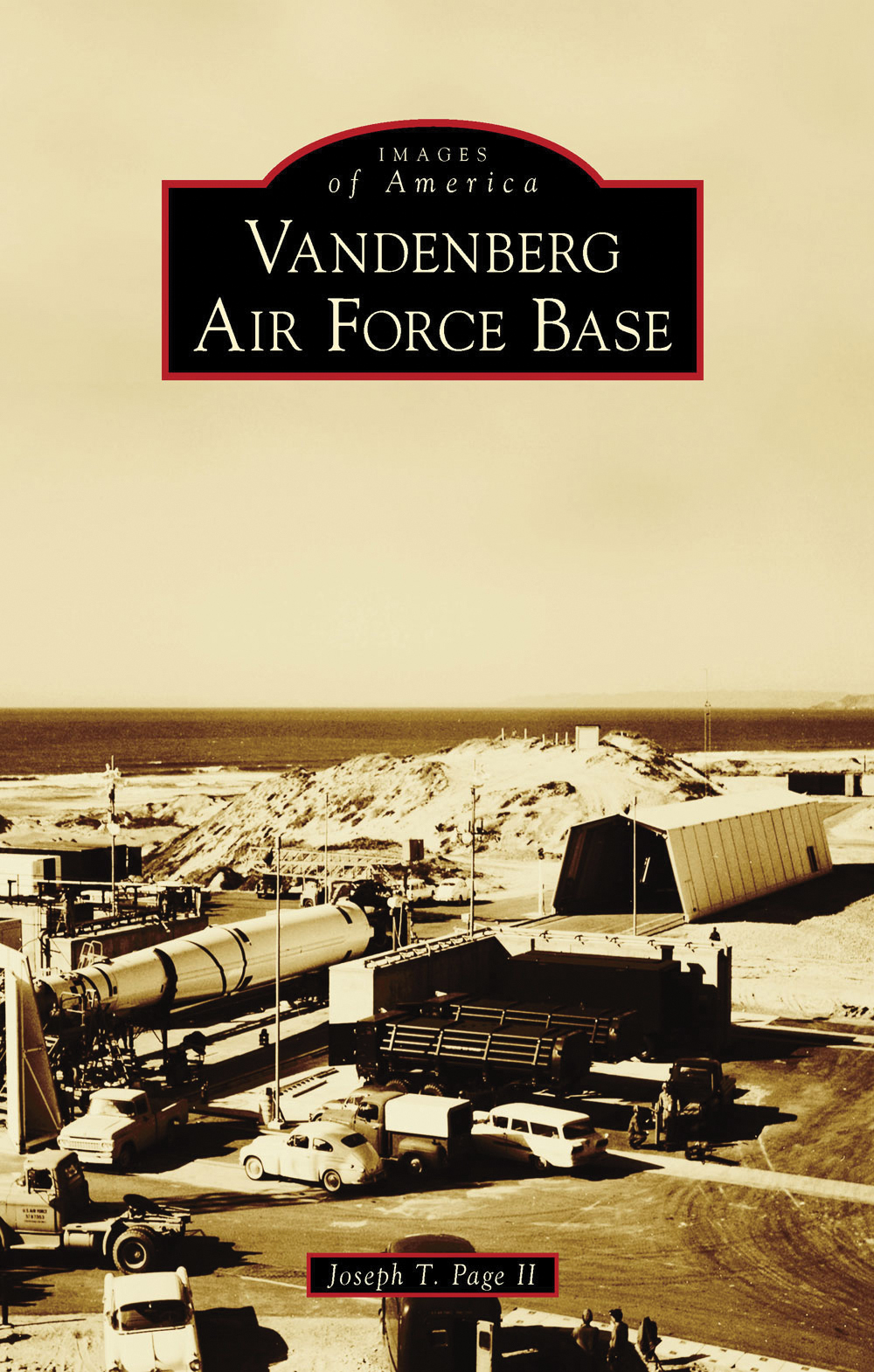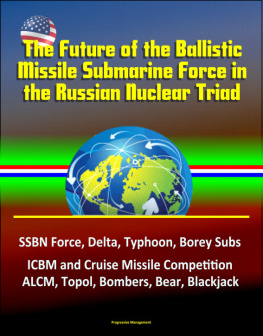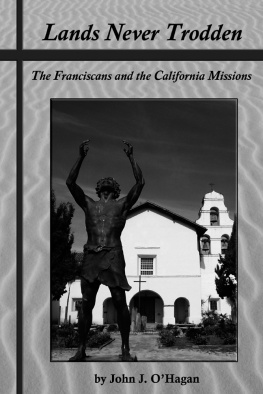
IMAGES
of America
VANDENBERG
AIR FORCE BASE
ON THE COVER: Pictured here on April 13, 1959, Thor/Agena launch vehicle No. 170 is being readied on Launch Pad 75-3-4 (later designated as SLC-1W). The mission was a Corona prototype and did not carry a camera. Capsule recovery failed, and due to a timing error, the capsule landed on Spitsbergen Island, Norway. The capsule was never found, though the search for it formed the basis for the book and film Ice Station Zebra. (US Air Force.)
IMAGES
of America
VANDENBERG
AIR FORCE BASE
Joseph T. Page II

Copyright 2014 by Joseph T. Page II
ISBN 978-1-4671-3209-1
Ebook ISBN 9781439648766
Published by Arcadia Publishing
Charleston, South Carolina
Library of Congress Control Number: 2014930446
For all general information, please contact Arcadia Publishing:
Telephone 843-853-2070
Fax 843-853-0044
E-mail
For customer service and orders:
Toll-Free 1-888-313-2665
Visit us on the Internet at www.arcadiapublishing.com
To Michael Keith Hardesty (19772012).
No stronger warrior, no greater friend, no better man could be found.
CONTENTS
ACKNOWLEDGMENTS
This book would not have been possible without the help of one man. He goes by many aliases: The Museum Guy, JP, and Mr. Sidetrakn. Donald Jay Prichard has been the soul of Vandenbergs history for decades. He has been the keeper of the flame, taking the stories of thousands of Vandenbergs occupants and distilling them into context (and humor) for generations to learn from. As a story keeper, his wisdom stretches into decades before his time as Minuteman maintenance non-commissioned officer and Pad Daddy at SLC-10. Props to him and puppy treats to his loyal companion, Sage.
Additional thanks to Chris Ryan and Esther Kenner from the Cultural Resources section of the 30th Civil Engineering Squadron, who knew where all the good stories and photos around base were buried. (Literally!) Special mention goes to fellow Gravelhauler Capt. Douglas Carmean for his insatiable love of missile history and pithy social media posts.
Special thanks to my editor Alyssa Jones and all the other professionals at Arcadia Publishing. They helped bring this amazing history to print.
I would also like to thank Lt. Col. Joseph Iungerman, Maj. Joseph Callaro, Lt. John P. Maggs, Jon Haeber, Jim Widlar, Wayne McMurry, Kade McMurry, Col. Charlie Simpson (Association of Air Force Missileers), and Col. David Arnold for their assistance. The help provided by the staff of the Vandenberg Library (Christine McLaughlin, Dianne Welch, and Joseph L. Carlson) was essential to the books completion. Additional thanks to Ms. Welch for her fathers postcards from Camp Cookes Korean Warera days.
Joe Valencias two books and photographs from the 1977 Honda Canyon fire captured a very sad time in Vandenbergs history. I am indebted to him for the photos of the fire. Thanks to artist Tim Gagnon for his donation of the STS-62A patch images.
Thanks to my parents, Joe and Kathy, for encouraging questioning and the search for wisdom. This drive has served me well.
As always, thanks to my baristas who kept the caffeine flowingKiesha, Taylor, Paul, Karrie, and Kayla.
Finally, Id like to thank my tribe for allowing me to write this book, and eternal love to my wife, Kim.
Unless otherwise credited, all photographs are courtesy of the United States Air Force.
INTRODUCTION
In many ways, the eyes of the world have been on this scant 45 miles of California coastline for centuries. The Chumash peoples roamed the hills and valleys of the Santa Barbara Channel area for millennia, long before the Spanish conquistador Juan Cabrillo arrived in 1542. Spanish expeditions through the area began in 1769, with Gaspar de Portolas expedition through what is now Vandenberg, heading toward Monterey. The colonization of Alta California was a joint venture between the Catholic Church and the Spanish Crown, which included the construction of a series of missions in the region for the inculcation of church values onto the indigenous population. The original mission in the area, Mission La Purisima Conception, was created in 1787. By 1803, the Chumash had been removed from the village of Nocto and moved to La Purisimaboosting its population to over 1,500. After the Mexican government began secularizing the mission system in 1833, the lands were divided into 11 secular ranches, totaling over 200,000 acres from land grants, which were given to loyal subjects.
Throughout the rest of the 1800s, the lands remained as rural ranches that celebrated the areas Spanish heritage. The Southern Pacific Railroad was completed in 1896, linking San Francisco and Los Angeles for passengers and cargo.
In 1901, the area saw the US Lighthouse Service build a lighthouse in the vicinity of Point Arguello. In 1911, the original tower was replaced with a standalone tower. Even with the lighthouse positioned on the point, however, the US Navy had its largest peacetime disaster on September 8, 1923, at Point Pedneralesalso known as Honda Point.
On that evening, seven destroyersthe USS Delphy (DD-261), USS S.P. Lee (DD-310), USS Young (DD-312), USS Woodbury (DD-309), USS Nicholas (DD-311), USS Fuller (DD-297), and USS Chauncey (DD-296)while traveling at 20 knots, ran aground at Honda Point a few miles from the northern side of the Santa Barbara Channel off Point Arguello on the coast in Santa Barbara County, California. Two other ships grounded, but were able to maneuver free of the rocks. Twenty-three sailors died in the disaster.
Accounts of the Honda Point disaster demonstrate that many actions were taken that seem inconceivable almost a century later. US Naval Historical Center records state that:
Just over twelve hours earlier, Destroyer Squadron ELEVEN (DesRon 11) left San Francisco Bay and formed up for a morning of combat maneuvers. In an important test of engineering efficiency, this was followed by a twenty-knot run south, including a night passage through the Santa Barbara Channel. In late afternoon, the fourteen destroyers fell into column formation, led by their flagship, USS Delphy. Poor visibility ensured that squadron commander Captain Edward H. Watson and two other experienced navigators on board Delphy had to work largely by the time-honored, if imprecise, technique of dead reckoning. Soundings could not be taken at twenty knots, but they checked their chartwork against bearings obtained from the radio direction finding (RDF) station at Point Arguello, a few miles south of Honda. At the time they expected to turn into the Channel, the Point Arguello station reported they were still to the northward. However, RDF was still new and not completely trusted, so this information was discounted, and DesRon 11 was ordered to turn eastward, with each ship following Delphy.
However, the Squadron was actually several miles north, and further east, than Delphys navigators believed. It was very dark, and almost immediately the ships entered a dense fog. About five minutes after making her turn, Delphy slammed into the Honda shore and stuck fast. A few hundred yards astern, USS S.P. Lee saw the flagships sudden stop and turned sharply to port, but quickly struck the hidden coast to the north of Delphy. Following her, USS Young had no time to turn before she ripped her hull open on submerged rocks, came to a stop just south of Delphy and rapidly turned over on her starboard side. The next two destroyers in line, Woodbury and Nicholas, turned right and left respectively, but also hit the rocks.
Next page










